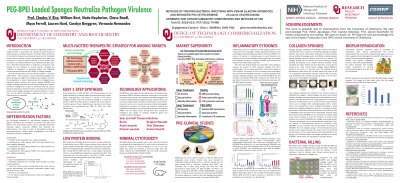Laboratory Research
(LR-041) PEG-BPEI Loaded Sponges Neutralize Pathogen Virulence
Friday, April 28, 2023
7:15 PM - 8:30 PM East Coast USA Time

William Best, BS; Neda Heydarian, MS; Chase Roedl, BS
Introduction: Chronic wound treatments must address the underlying factors that inhibit healing, such as (1) drug-resistant pathogens, (2) biofilms, and (3) inflammation from pathogen associated microbial pattern molecules (PAMPs). Data show that one molecule -- 600 Da BPEI that is PEGylated to improve safety -- accomplishes these 3 goals.
Methods: PEG-BPEI is cationic and uses electrostatics for binding with anionic sites on Gram-positive and Gram-negative bacteria. PEG-BPEI and the bioactive moiety 600 Da BPEI, have broad-spectrum activity to counteract (1) antimicrobial resistance (AMR) caused by the Gram-negative LPS layer; (2) AMR caused by Gram-positive cell wall and teichoic acids (3) AMR caused by metallo-β-lactamases; (4) Release of pro-inflammatory cytokines in response to the Gram-negative pathogen associated molecular pattern molecules (PAMPs) LPS and peptidoglycan; (5) Release of pro-inflammatory cytokines in response to the Gram-positive PAMPs teichoic acids and peptidoglycan; and (6) Biofilms formed by Gram-negative pathogens; and (7) Biofilms formed by Gram-positive pathogens.
Results: Checkerboard assays using microtiter plates demonstrate the antibiotic properties. Growth curves demonstrate bacteriostatic effects. Scanning electron microscopy (SEM) was used to confirm that the combination treatment leads to abnormal morphology. Data collected with isothermal titration calorimetry and fluorescence spectroscopy demonstrate a mechanism of action. ELISA was used to neutralize endotoxins (LPS, LTA, peptidoglycan) that otherwise stimulate pattern recognition receptors, leading the release of pro-inflammatory cytokines. Additional data show that PEG-BPEI can be absorbed onto, and released from, sponges created with natural and synthetic polymers. Efficacy of PEG-BPEI using in vivo models is demonstrated.
Discussion: PEG-BPEI differs from existing technology because it neutralizes virulence factors simultaneously through independent mechanisms of action. Current approaches against wound pathogens are valid, but only address 1 or 2 of the aggravating factors, such as antibiotic resistance, endotoxins, protease activity, biofilms, or inflammation. PEG-BPEI also differs from existing technology because it is not a peptide and thus resists proteolysis, unlike cationic peptides and peptide mimetics susceptible to rapid proteolytic degradation and/or protein binding.
Methods: PEG-BPEI is cationic and uses electrostatics for binding with anionic sites on Gram-positive and Gram-negative bacteria. PEG-BPEI and the bioactive moiety 600 Da BPEI, have broad-spectrum activity to counteract (1) antimicrobial resistance (AMR) caused by the Gram-negative LPS layer; (2) AMR caused by Gram-positive cell wall and teichoic acids (3) AMR caused by metallo-β-lactamases; (4) Release of pro-inflammatory cytokines in response to the Gram-negative pathogen associated molecular pattern molecules (PAMPs) LPS and peptidoglycan; (5) Release of pro-inflammatory cytokines in response to the Gram-positive PAMPs teichoic acids and peptidoglycan; and (6) Biofilms formed by Gram-negative pathogens; and (7) Biofilms formed by Gram-positive pathogens.
Results: Checkerboard assays using microtiter plates demonstrate the antibiotic properties. Growth curves demonstrate bacteriostatic effects. Scanning electron microscopy (SEM) was used to confirm that the combination treatment leads to abnormal morphology. Data collected with isothermal titration calorimetry and fluorescence spectroscopy demonstrate a mechanism of action. ELISA was used to neutralize endotoxins (LPS, LTA, peptidoglycan) that otherwise stimulate pattern recognition receptors, leading the release of pro-inflammatory cytokines. Additional data show that PEG-BPEI can be absorbed onto, and released from, sponges created with natural and synthetic polymers. Efficacy of PEG-BPEI using in vivo models is demonstrated.
Discussion: PEG-BPEI differs from existing technology because it neutralizes virulence factors simultaneously through independent mechanisms of action. Current approaches against wound pathogens are valid, but only address 1 or 2 of the aggravating factors, such as antibiotic resistance, endotoxins, protease activity, biofilms, or inflammation. PEG-BPEI also differs from existing technology because it is not a peptide and thus resists proteolysis, unlike cationic peptides and peptide mimetics susceptible to rapid proteolytic degradation and/or protein binding.

.png)